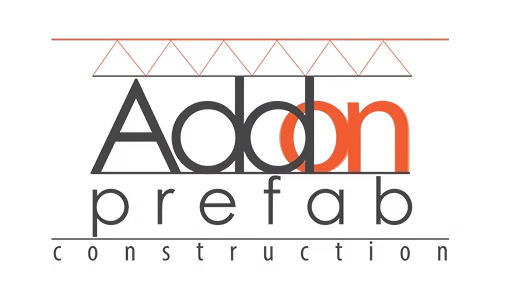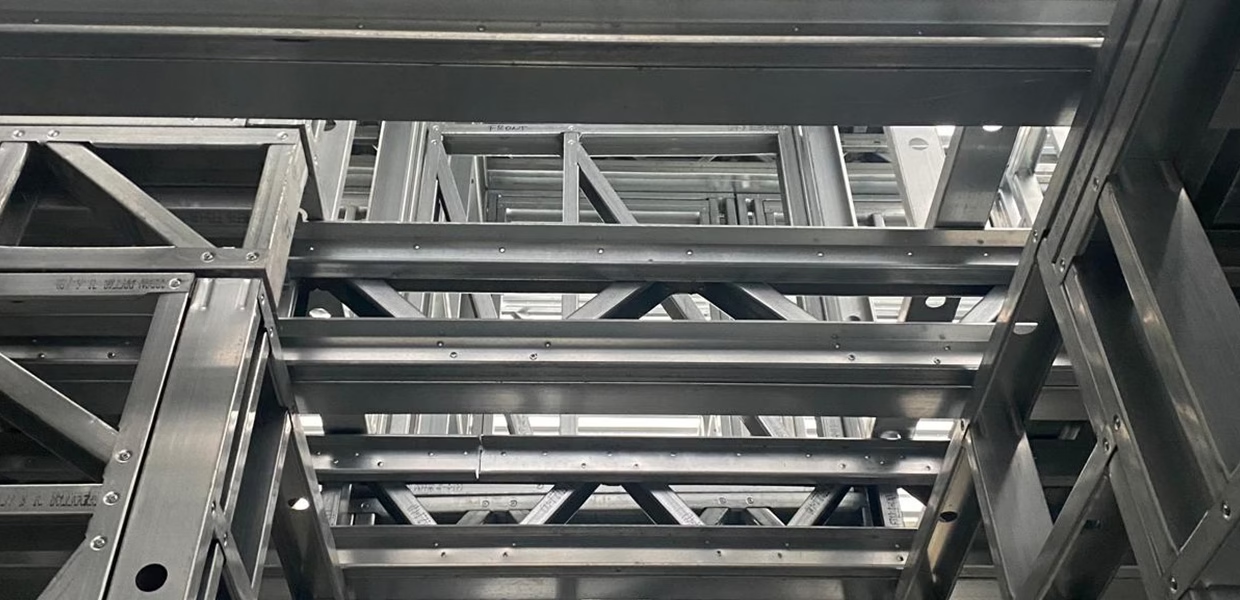Steel Frame Applications by Addon Prefab
Prefabrication with light gauge steel is rapidly gaining acclaim in the construction industry, embraced by contractors and building firms around the globe. The versatility and efficiency of light gauge steel construction offer timely and effective building solutions.
Light gauge steel is suitable for a wide array of steel frame applications, including residential buildings, industrial facilities, facades, modular buildings, warehousing, solar panel mounts, and more. This adaptable prefabrication system facilitates the design and construction of web joists, trusses, structural framing, and internal partitions, accommodating diverse construction needs.
The benefits of utilising light gauge steel in construction are unparalleled. From significant time savings and quality assurance to reduced noise pollution and eco-friendly practices, light gauge steel represents the future of sustainable construction. With its precision and minimal waste, projects not only meet deadlines but also exceed environmental standards.
Let’s delve deeper into the various innovative applications of light gauge steel and explore how Addon Prefab is at the forefront of this construction revolution.
Residential Solutions
The residential construction industry has witnessed tremendous growth in the use of steel frame applications in recent years. The increasing demand is driven by the numerous advantages that light gauge steel offers in residential building projects. Prefabrication with steel frames not only reduces costs by minimising the load on building foundations, but it also accelerates construction timelines through advanced offsite technologies.
In the fast-paced residential housing market, speed is crucial. The use of light gauge steel drastically cuts down on construction setup time, enabling new homeowners to move in sooner, which is particularly important in rapidly growing urban areas. This swift construction process does not compromise on quality or structural integrity. According to the UK-based Steel Construction Institute, the lifespan of a well-maintained steel frame structure can reach up to 250 years. Additionally, steel’s resistance to mold and termites makes it an ideal choice for sustainable residential development.
Steel frame constructions also excel in providing thermal insulation, significantly reducing heat loss and thus decreasing the energy consumption needs of a residential complex. Moreover, the acoustic isolation properties of steel enhance the living experience by minimising noise, contributing to a more serene environment for residents and increasing property value.
In terms of safety, the durability that a light gauge steel frame offers excellent fire resistance and the ability to withstand seismic shocks. The non-combustible nature of steel further ensures safety, making it a reliable choice for developers focused on creating secure, sustainable homes.
With Addon leading the way, integrating light gauge steel into residential projects transforms construction into a more efficient, cost-effective, and environmentally friendly process, paving the path to a future of innovative residential design.
Industrial Solutions
Steel frame construction has emerged as the preferred choice for industrial buildings, accounting for the vast majority of industrial shed structures. The effectiveness and efficiency of light gauge steel make it an ideal solution for creating large-scale industrial facilities quickly and cost-effectively.
One of the defining characteristics of industrial buildings is the need for expansive spaces to accommodate equipment, products, raw materials, and various essential components. Light gauge steel is perfectly suited for distribution centers, supermarkets, and other industrial units, providing the structural integrity required for such operations.

Compared to concrete, steel constructions boast a superior strength-to-weight ratio. This incredible durability allows steel frames to support substantial structures without consuming excessive space. Furthermore, because steel constructions are often prefabricated offsite, customisation is straightforward, enabling tailored solutions for each industrial unit. Should the need arise for future modifications or expansions, steel frame construction offers the flexibility to seamlessly adapt to the evolving requirements of any industrial complex.
In addition to their robust physical properties, steel frame constructions ensure high thermal insulation performance, maintaining a stable indoor climate by minimising heat loss. The resilience of steel against challenging outdoor conditions—such as strong winds, extreme heat, and heavy rainfall—makes it an unparalleled choice for industrial applications.
The lightweight nature of steel contributes to impressively fast construction times, allowing for rapid setups without sacrificing quality. Sustainability is another critical advantage; steel frame construction provides long-term value with its high durability and low maintenance costs. Moreover, steel is 100% recyclable, meaning industrial buildings have a minimal environmental impact.
Our commitment to employing light gauge steel for industrial projects ensures that we deliver solutions that are not only economically viable but also environmentally responsible, paving the way for a sustainable future in industrial construction.
Renovation Solutions
When it comes to renovating and remodelling outdated buildings, light gauge steel is an outstanding choice. Whether repurposing interiors for different uses or enhancing existing structures, steel frame constructions provide the structural integrity necessary for both functionality and aesthetic appeal.
Utilising steel in renovation projects ensures an impressive setup speed due to the prefabrication process, where components can be preassembled before arrival at the construction site. This efficiency makes steel frame construction one of the quickest and most cost-effective methods for adding new internal separating walls, bathrooms, staircases, and more to existing buildings.

The unique structure of light gauge steel frames enhances the acoustic and thermal insulation qualities of renovated spaces, making them ideal for various environments, whether residential, commercial, or industrial. These attributes not only contribute to occupant comfort but also increase energy efficiency.
Cost savings are a significant benefit of steel frame constructions, resulting from the rapid setup time, relatively low delivery costs, durability, low maintenance requirements, and superior thermal insulation. Additionally, the lightweight nature of steel minimises the impact on existing structures, allowing for reinforcement where needed.
Importantly, steel frame construction offers non-combustible qualities. This means that during renovations, the use of light gauge steel contributes to a fire-resistant environment, enhancing safety.

With Addon’s expertise in prefabrication and light gauge steel, your renovation projects can achieve remarkable results that marry efficiency, sustainability, and style. Let us help you transform your space with our innovative steel frame solutions.
Topping Up Solutions
Light gauge steel frame applications are ideally suited for adding an extra floor or a mansard roof to an existing building. Their lightweight design allows for a variety of over-roof options, ranging from sturdy, classic constructions to intricate geometric designs.
Unlike structures made from heavier materials, steel frames enable the construction of additional roofing without imposing detrimental loads on the underlying building. Thanks to their lightweight and durable nature, light gauge steel frames are the perfect choice when an existing structure cannot bear excessive pressure on its foundations.

The lightweight properties of steel frame construction facilitate the addition of a top floor or over-roof with minimal modifications needed to the existing foundation compared to alternatives using heavier materials. Moreover, steel frame constructions not only offer advantages in weight and durability over wood, but they also accelerate the building process.
Using steel frame constructions for topping up a building is significantly more cost-effective than other options. The reduced setup time associated with steel-based construction translates to lower labor costs. Additionally, since light gauge steel is recyclable, the expenses related to clearing construction sites are minimized.
Despite their lightweight design, steel frame constructions are exceptionally durable. This durability ensures that the additional top floor and roof can withstand harsh climatic conditions, including fluctuations in humidity and temperature, as well as strong winds.
Modular Solutions
Light gauge steel frame modular constructions deliver highly effective solutions for rapidly establishing new buildings, often in just a matter of days. These steel frame modules are pre-fabricated offsite and then transported to the desired location, where they can be quickly assembled. Unlike timber frames, steel frame modules require no additional preparation and can be set up immediately upon arrival, enhancing speed and efficiency, which in turn lowers overall costs.

There is a common misconception that modular homes resemble boxes; while this may have been true in the past, modern designs have evolved significantly. The strength of light gauge steel allows for the construction of contemporary, aesthetically pleasing buildings. Additionally, steel frame applications enable modular setups on steep or challenging terrains, expanding the possibilities for location.
Steel frame modules outshine most other materials, such as timber, due to their enhanced fire resistance and strong connections, resulting in exceptional structural integrity. The high quality of steel frame modules ensures they arrive on-site without damage, and once assembled, these buildings are completely safe and robust.
The manufacturing process for steel frame modules also contributes to a minimal environmental impact. With an incredibly long lifespan, light gauge steel can be recycled at the end of a building’s life cycle, allowing for sustainable use of materials.

